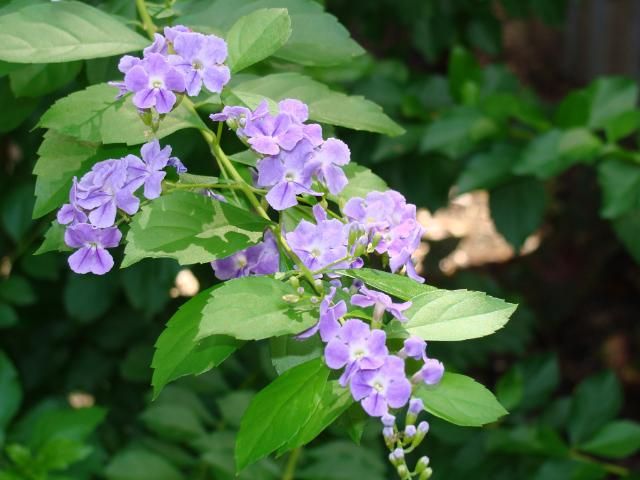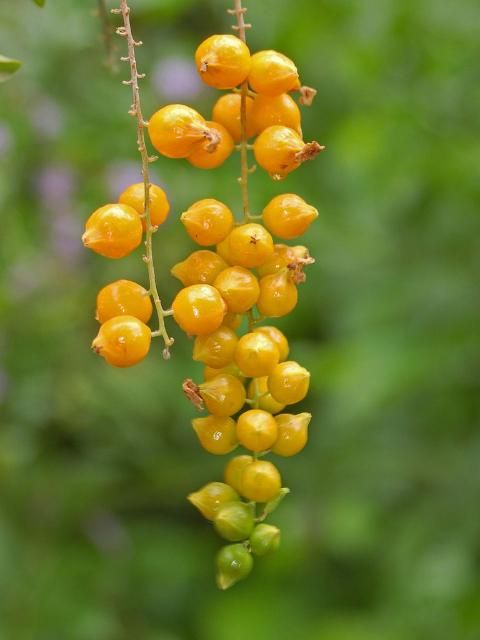Family
Verbenaceae, verbena or vervain family.
Genus
Is derived from the name of Castore Durantes, an Italian botanist.
Species
The species name, erecta, is a Latin word meaning "upright."
Common Name
Golden Dewdrop, Pigeon Berry, Sky Flower
The common name golden dewdrop comes from its showy, dropping trails of golden fruits.
Description
The origin of this small evergreen tree is subject to debate. Some sources claim it is native to the West Indies and Central America, while others claim it is native to the Florida Keys. It currently can be found in many states within the sun belt of the United States, including Florida, Louisiana, Texas, Arizona, California, and Hawaii. It grows best in full sunlight but will tolerate partial shade, and can reach heights of up to 18 feet. The simple and oppositely arranged leaves grow from 1 to 3 inches long, are ovate to obovate in shape, and have serrate margins. The leaves are yellow-green, glabrous (or hairless) and thin, and each one possesses a thorn on the bottom side along the rachis (stem). The bark of the golden dewdrop tree is light brown and slightly furrowed. Small, showy, tubular flowers, ranging from purple and white to violet or blue, bloom in the spring and hang in 6-inch racemes. Bright yellow spherical fruits about ½ inch in diameter hang in long, trailing clusters in the summer. Caution: the fruits of golden dewdrop are poisonous to humans.

Credit: PseudoDude, CC BY-SA 2.0

Credit: Ettore Balocchi, CC BY 2.0
Allergen
Golden dewdrop is known to be slightly allergenic.
Applications
Horticultural
Landscapers and horticulturalists use golden dewdrop trees for background and screening purposes. It creates a nice private barrier, and the bright lavender flowers and attractive golden fruit add a splash of color to landscapes. It is commonly seen in yards as a shrub and is used in urban landscapes in parts of southern Florida.
Wildlife
Butterflies enjoy nectar from the flowers, and although the fruit is poisonous to humans, birds are able to use the berries as a food source.
References
Borror, D. J. 1988. Dictionary of root words and combining forms (1st ed.). Mountain View, CA: Mayfield Publishing Company.
Dehgan, B. 1998. Landscape plants for subtropical climates. Gainesville, FL: University Press of Florida.
Ogren, T. L. 2000. Allergy-free gardening: The revolutionary guide to healthy landscaping. Berkeley, CA: Ten Speed Press.
Rushing, F. 2005. Tough plants for Florida gardens: Low care, no care, tried and true winners. Franklin, TN: Cool Springs Press.
Watkins, J. V., T. J. Sheehan, and R. J. Black. 2005. Florida landscape plants: Native and exotic (Second Revised ed.). Gainesville, FL: University Press of Florida.
USDA Natural Resources Conservation Service. (n.d.). PLANTS database. Retrieved from http://plants.usda.gov/index.html
Floridata.com. 2003. Duranta erecta, Retrieved from http://www.floridata.com/ref/D/dura_ere.cfm